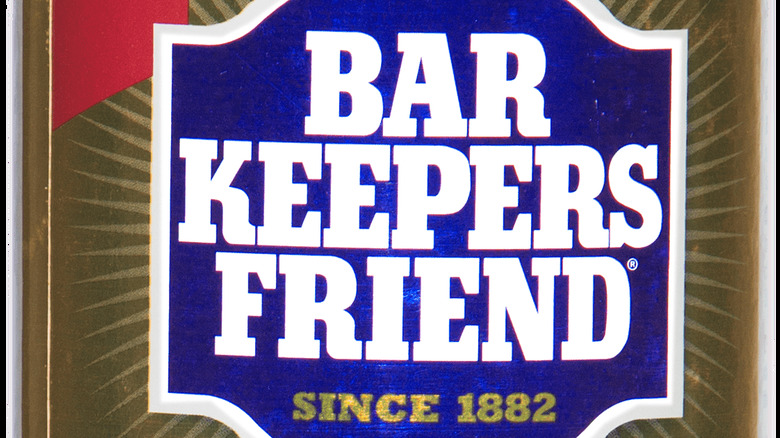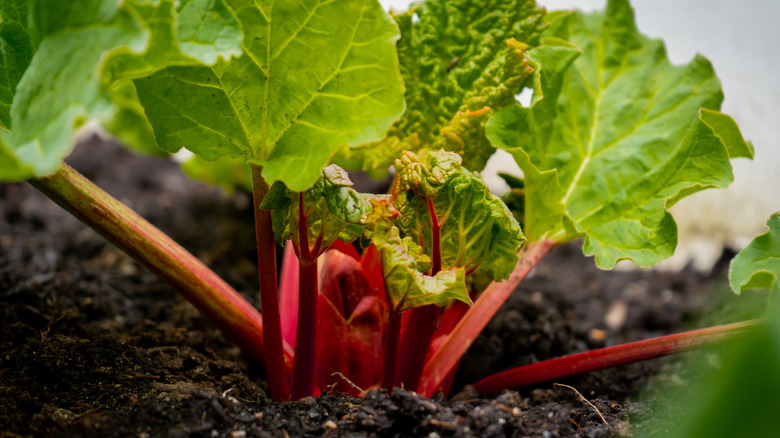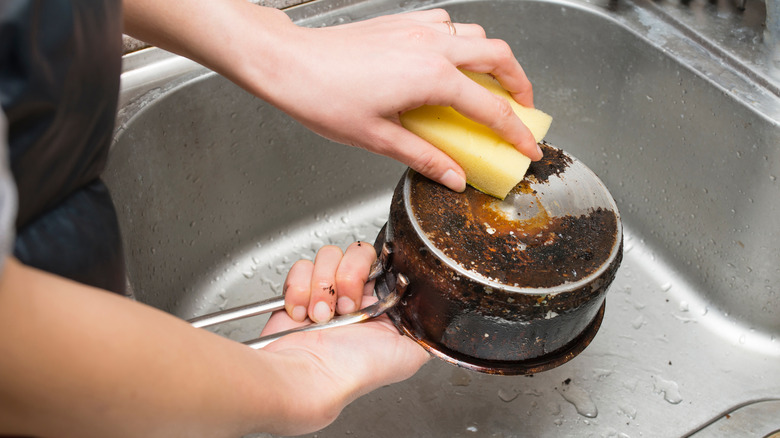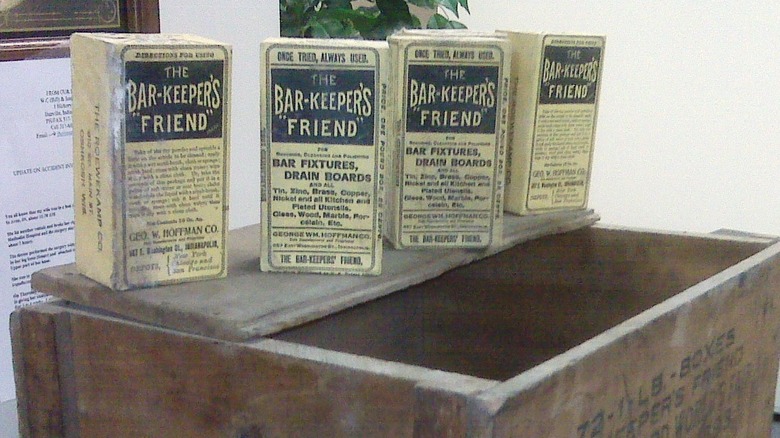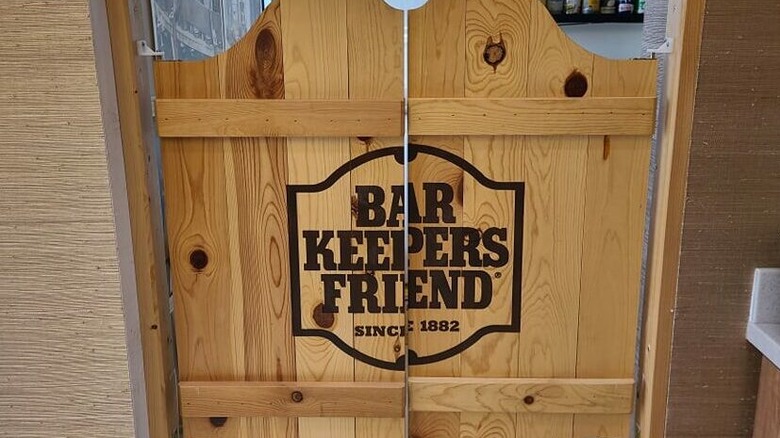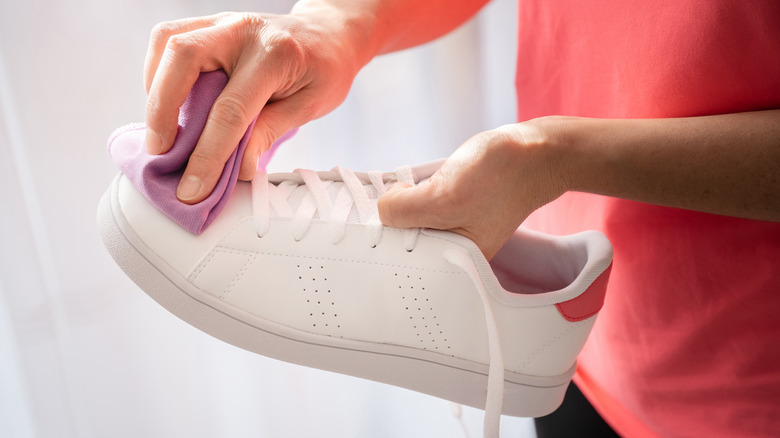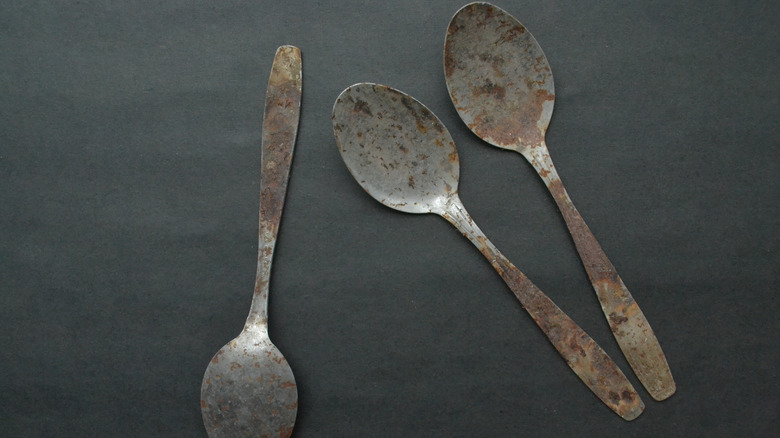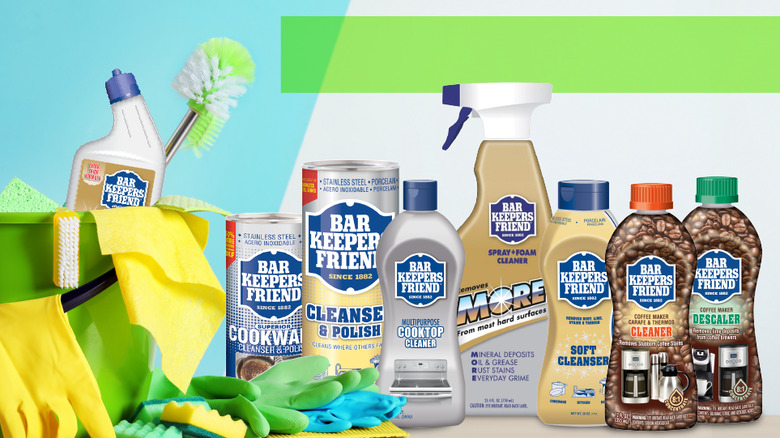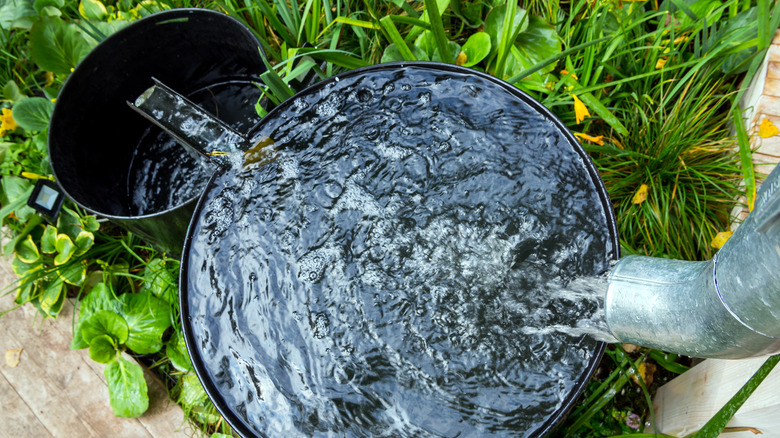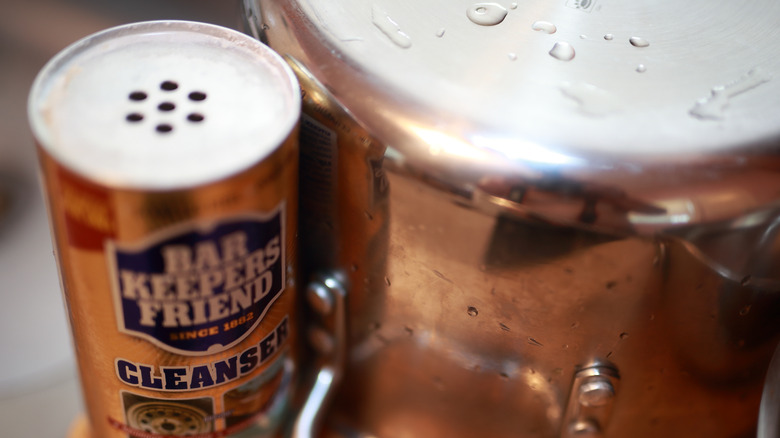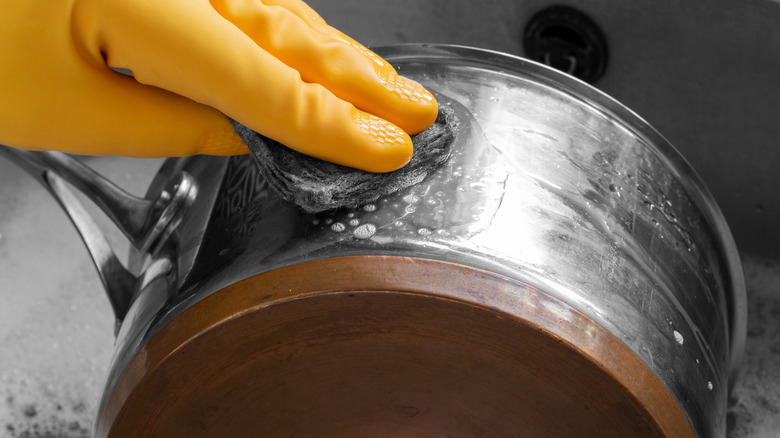The Untold Truth Of Bar Keepers Friend
Whether you first learned about it from an aunt whose cookware was never anything less than sparkling (no matter how many family holidays she hosted), or you heard of the powerful cleanser on the Internet (where it's now extra famous), you might know a thing or two about Bar Keepers Friend. You might even call it your friend. But what don't we know about this friend? What else is there to this product people love to evangelize? What's so special about it? Where did it come from? And does the formula date back as far as its old-timey label and no-frills packaging suggests?
We found out the untold truth of Bar Keepers Friend, from its backstory to the very interesting people involved and how you should (and shouldn't) use the stuff in your kitchen, bathroom, garage and beyond. Here are the highlights on what you need to know before befriending the classic cleanser.
Bar Keepers Friend's secret ingredient comes from food
So what is it about this stuff that sets it apart from other cleansers? An active ingredient in Bar Keepers Friend is oxalic acid, which just happens to occur naturally, in high amounts, in the rhubarb plant (which is actually a vegetable). Oxalic acid is also found in other foods such as spinach, strawberries, nuts, chocolate, and more (per the USDA).
In fact, BobVila reports that the product was dreamed up after its inventor cooked some rhubarb in a particularly tarnished pan. After cooking, George William Hoffman noticed that the nasty old pan was suddenly clean and shiny. It just so happened this home cook was also a chemist who sold cleaning products. Hoffman had stumbled upon something pretty great, and set about creating a formula that included the stuff. Oxalic acid is still an active ingredient in Bar Keepers Friend today.
It's not just the acid that makes Bar Keepers Friend work
Yes, oxalic acid is the active ingredient that sets the product apart, and definitely the major reason Bar Keepers Friend powder works. But the other component that helps it really clean? Abrasives. These tiny tough particles give Bar Keepers Friend a texture just a little rougher than baking soda and lend the powder real scrubbing power — but it still doesn't scratch your cookware.
So what are those abrasives made of? According to the Bar Keepers Friend's safety data sheet, feldspar. The Industrial Minerals Association describes feldspar as a group of plentiful minerals found in our Earth's crust. Feldspar can be used as a mild abrasive, and so much more — feldspar is used in glass, ceramics, and even paint. It's essentially a rock. So when you use Bar Keepers Friend, you could say you're scrubbing with rhubarb and rocks.
A WWII Navy and CIA veteran took over Bar Keepers Friend in 1956
Navy and CIA veteran Dr. Beurt SerVaas had first learned about the product from his grandmother, who used the product in her kitchen. Armed with this knowledge, SerVaas later used the product at his electroplating business before taking ownership of Bar Keepers Friend in 1956.
But Dr. SerVaas was no ordinary businessperson. As told in his 2014 obituary in the Saturday Evening Post, Dr. SerVaas had to learn Spanish to qualify for jobs he was after, so he borrowed $35 from his grandfather to hitchhike to Mexico City, where he studied at the University of Mexico before returning to the U.S. to finish his studies. As a naval officer in World War II, he was sent on a potential suicide mission and was successful in his part in demanding Japanese surrender.
His accomplishments only continued after his service, as he bought, led, and revived businesses in the Indianapolis area and beyond. SerVaas was a serial entrepreneur who was later credited with "rescuing" the Saturday Evening Post in the 1970s. Today, Bar Keepers Friend remains based in Indianapolis and under SerVaas family ownership.
2022 is the 140th anniversary of Bar Keepers Friend
One look at the product's packaging and you might be able to tell this cleanser & polish has been around a long time. But would you have guessed Bar Keepers Friend was first sold in 1882? The Washington Post reports that back then, the powder was sold in brown paper bags.
And Bar Keepers Friend is not the only long-lived company founded in this era of entrepreneurship: at the time, the Bell Telephone Company was just five years old after Alexander Graham Bell's invention of the telephone, while Dow Jones & Company got its start in financial journalism in November of 1882.
While telephones have changed quite a bit (try explaining to a child why we say we "hang up" after a call), and the media and financial landscape is almost unrecognizably different in the U.S. than it was 140 years ago, Bar Keepers Friend has stayed largely the same.
The Bar Keepers Friend logo represents the swinging doors of a saloon
It's so subtle you might not have noticed, but the logo is in the shape of two old-fashioned saloon doors in honor of the product's history. While the product has had different logos and packaging throughout its long history, this one pays special homage to the company's roots (according to the company itself).
Bar Keepers Friend was first sold to tavern and saloon owners because, at the time, their businesses held some of the largest concentrations of metal wares around. Stainless steel wasn't in residential kitchens since it wasn't invented until 1913, according to the British Stainless Steel Association, and most homes didn't have a lot of copper pots or other metal materials.
Expansive brass rails, however, were common in taverns, where they served as a footrest for standing drinkers who leaned on the bar. Per Imbibe Magazine, this was before bar stools were common in saloons. Foot rails served the purpose of making drinkers more comfortable and perhaps, more likely to drink (and spend) more. Bar Keepers Friend was sold as a hard-working polish that would wipe away the daily beating those large rails would take.
You can clean your sneakers with Bar Keepers Friend
White sneakers look great until they're no longer white, right? While bleach might come to mind for brightening your kicks, Bar Keepers Friend can actually work on tough shoe stains, too. Keep a can near a utility sink at home for cleaning grimy shoes.
Bar Keepers Friend can work on shoes of other colors, too. The powder cleanser doesn't contain any bleach, so you don't have to worry about it discoloring or staining the colorful parts of your sneakers.
Take some advice from everything home expert Bob Vila: To clean, dab a soft, dampened cloth with Bar Keepers Friend powder cleanser and scrub. For tougher or more textured parts of your shoes, scrub with a paste of Bar Keepers Friend and water using a toothbrush. Let the paste sit and work its magic a minute before you thoroughly rinse off your shoes.
Bar Keepers Friend works on rust
Save your rusty utensils, car parts, and tools from a bleak future in the landfill by scrubbing off rust with Bar Keepers Friend. Yes, there are other products specifically marketed for use on rust, but who doesn't love a multitasker that can clean everyday messes and save things that nearly need refurbishing?
To remove rust, make a paste of Bar Keepers Friend powder cleanser and water. Spread over rusted areas and let it sit for a minute before scrubbing it away with a sponge or cloth. For harder-to-reach areas, the Family Handyman recommends using a cotton swab to really get in there and get your goods looking brand new. So next time you're thinking of throwing in the towel and tossing something because of rust, give Bar Keepers Friend a try and save yourself (and the planet) the expense of replacing your hard-working tools and utensils.
Bar Keepers Friend makes more products than you might realize
Yes, it all started with the powder cleanser and polish (which you can use on a lot of materials itself) but nowadays the Bar Keepers Friend product line has an option for almost every surface in your home and garage (as SFgate reports). Have stubborn coffee stains on your coffee maker or thermos? There's a special product just for that. Need a coffee descaler? No problem.
Some of these products also contain the oxalic acid that Bar Keepers Friend is so committed to using, while others are made with other active ingredients targeted for different surfaces. There's even a Bar Keepers Friend toilet bowl cleaner, which, if it makes cleaning toilets even a little bit easier or faster, has to be worth checking out. The company even goes so far as to sell an institutional line of cleansers for tackling industrial-sized messes.
Bar Keepers Friend uses rainwater for their liquid products
You might be surprised to learn that such a legacy company (with old-fashioned branding) is forward-looking when it comes to the environment, according to the brand's website.
As the rise of refillable, concentrated detergents on the market points out (as reported by Bloomberg), making a product such as Bar Keepers Friend cleanser & polish without water can save production, shipping, and packaging costs as well as packaging materials such as single-use plastics that are harmful to the environment.
But some products from their broader line are made with water. And because the company is committed to environmental stewardship, the company states that over half of the water used in all of their liquid-based products comes from rainwater collection. But don't let that make you think the water isn't clean— before it's used, it's filtered and UV sterilized for safety. Further, Bar Keepers Friend claims that all of their products are sustainably produced. Not bad for a 140-year-old brand, if we say so.
Inhaling Bar Keepers Friend can be dangerous
The ingredients in the powder cleanser, from the oxalic acid to surfactants that help Bar Keepers Friend bind to greasy messes, can be a respiratory hazard if inhaled (per the Kitchn). To avoid accidental inhalation, be sure to dampen your surfaces before adding the powder or get the powder wet immediately upon use. Don't try using Bar Keepers Friend in areas of your home where water for thorough rinsing is not readily available.
The Kitchn makes note of another hazard — don't breathe in Bar Keepers Friend and other cleansers such as ammonia or bleach at the same time. The mixture of these products can cause dangerous respiratory effects.
If you use Bar Keepers Friend regularly (and as directed), though, you shouldn't have to worry about any negative long-term effects. According to the product's safety data sheet, the ingredients in the cleanser & polish don't contain any known carcinogens.
There's a reason Bar Keepers Friend doesn't have a lid
You might not think it to look at them, but when it comes to manufacturing, lids are expensive. And at around $3 per can on Amazon or at your grocery store, Bar Keepers Friend is not too pricy. According to the company's FAQ page, a lid is not necessary to keep the product in good condition. The design of the can, and the composition of its contents help it stay shelf-stable in dry conditions without a lid.
If you want to seal your product, let's say if you're storing it in a wetter area near or under the kitchen sink, you can buy a reusable lid that fits on Bar Keepers Friend as well as other products such as Comet. Want to DIY it instead? Bar Keepers Friend suggests sealing a plastic sandwich bag with a rubber band around the top of your can.
Bar Keepers Friend is so powerful, you have to be careful using it
Letting dishes soak with soapy water is a great way to reduce the amount of elbow grease you need to use to get your cookware spotless. So it stands to reason that soaking with Bar Keepers Friend would get everything super-duper clean, right? Wrong. This delightful account from Bon Appetít points out that oxalic acid's cleansing power is so potent that soaking with the stuff is not recommended for longer than one minute at a time. (They also recommend wearing gloves while you use Bar Keepers Friend, but that's up to you and your skin's sensitivity.)
Letting dishes soak with the stuff for longer than that minute can etch, or scratch, your precious pans beyond repair. If your dishes aren't as clean as you'd like after a minute-long soak, rinse and repeat until you achieve the shiny, like-new results you're after.
